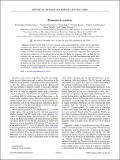Plasmonics in argentene
Author(s)
Sundararaman, Ravishankar; Christensen, Thomas; Ping, Yuan; Rivera, Nicholas; Joannopoulos, John D; Soljačić, Marin; Narang, Prineha; ... Show more Show less
DownloadPublished version (851.1Kb)
Publisher Policy
Publisher Policy
Article is made available in accordance with the publisher's policy and may be subject to US copyright law. Please refer to the publisher's site for terms of use.
Terms of use
Metadata
Show full item recordAbstract
© 2020 American Physical Society. Merging concepts from the fields of ab initio materials science and nanophotonics, there is now an opportunity to engineer new photonic materials whose optical, transport, and scattering properties are tailored to attain thermodynamic and quantum limits. Here we present first-principles calculations predicting that Argentene, a single-crystalline hexagonal close-packed monolayer of Ag, can dramatically surpass the optical properties and electrical conductivity of conventional plasmonic materials. In the low-frequency limit, we show that the scattering rate and resistivity reduce by a factor of 3 compared to the bulk three-dimensional metal. Most importantly, the low scattering rate extends to optical frequencies in sharp contrast to, e.g., graphene, whose scattering rate increase drastically in the near-infrared range due to optical-phonon scattering. Combined with an intrinsically high carrier density, this facilitates highly confined surface plasmons extending to visible frequencies. We evaluate Argentene across three distinct figures of merit, in each outperforming the state-of-the-art, making it a valuable addition to the two-dimensional heterostructure toolkit for quantum optoelectronics.
Date issued
2020Department
Massachusetts Institute of Technology. Department of PhysicsJournal
Physical Review Materials
Publisher
American Physical Society (APS)